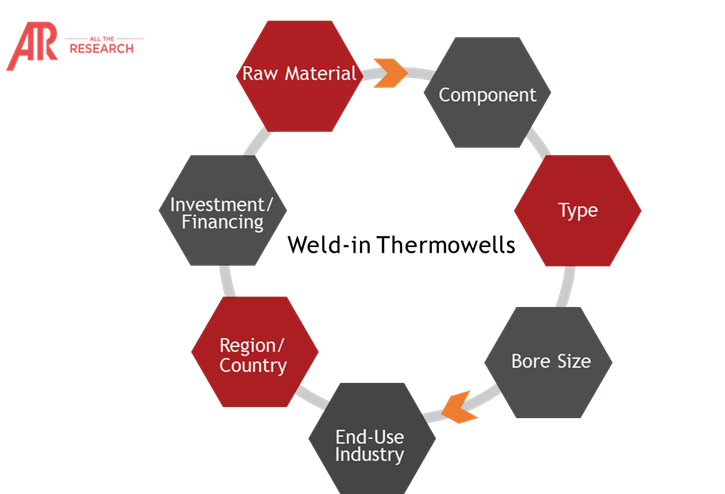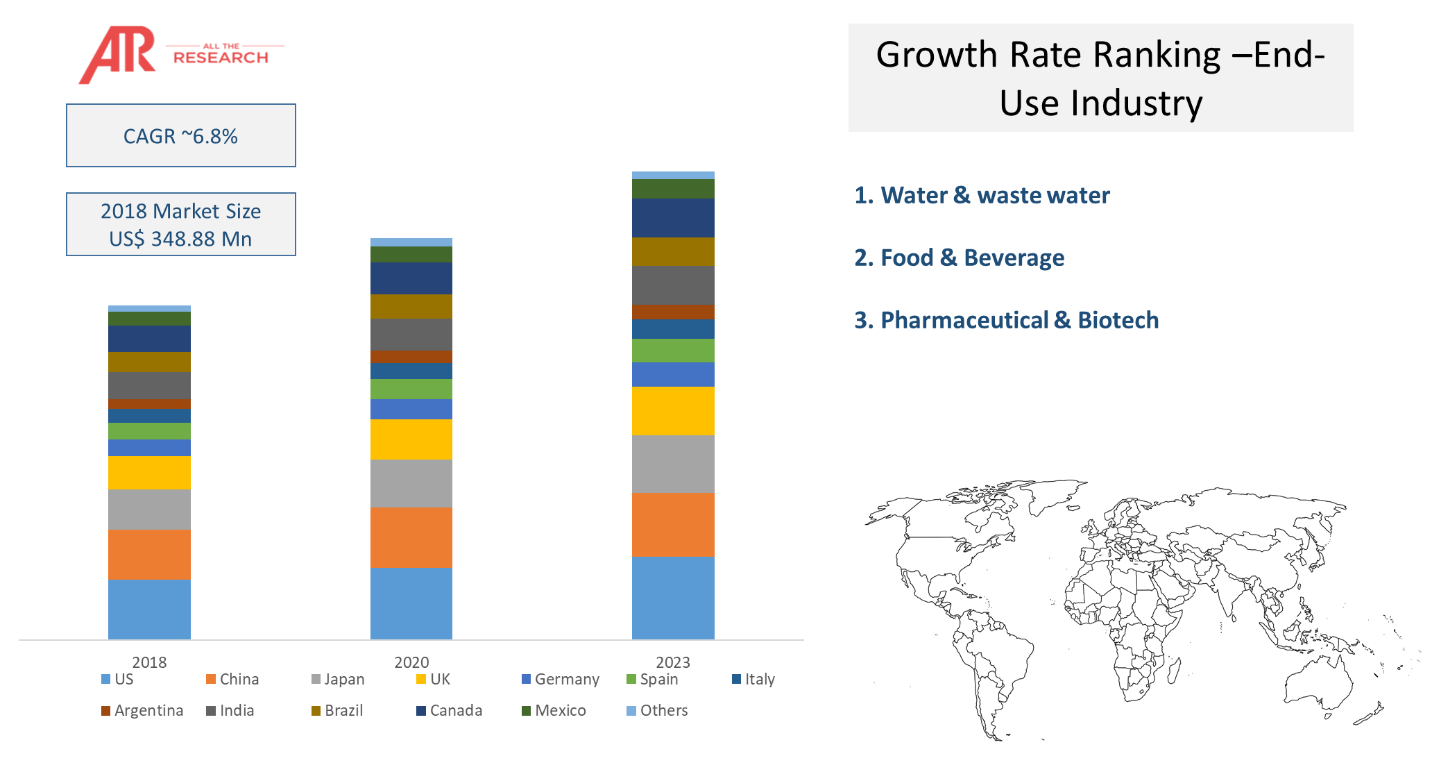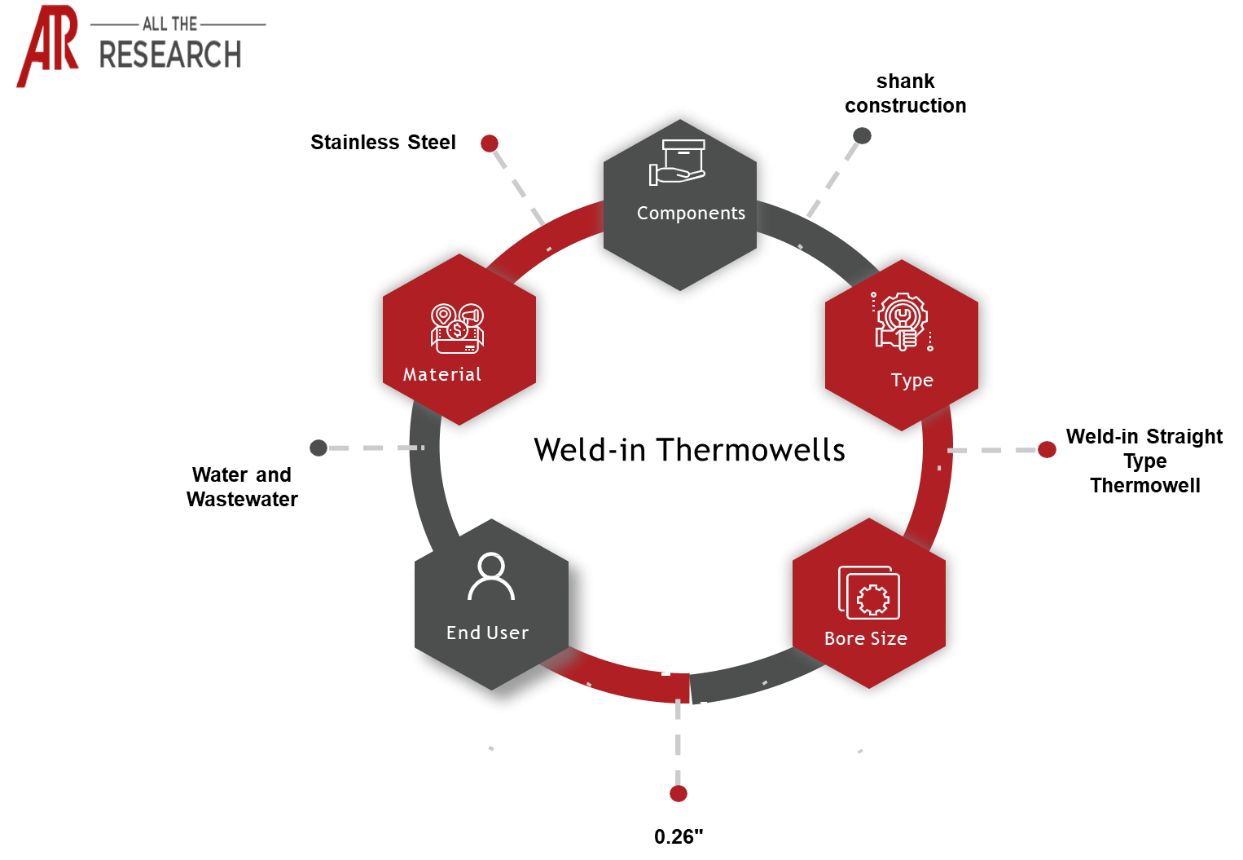According to AllTheResearch’s analysis, the global weld-in thermowells market ecosystem was valued at US$ 348.88 Mn in 2018 and is expected to reach US$ 590.69 Mn by the year 2026, growing at a CAGR of 6.8%. Thermowells are cylindrical fittings that are used to protect temperature sensors such as thermocouples, bimetallic, and thermometers and thermistors installed in industrial processes. There are different types of thermowells such as flanged thermowells, threaded thermowells, socket well thermowells, amongst others. Weld-in thermowells are particularly used for high pressure, high velocity applications where corrosive process media exist. Growing industrialization is one of the major factors in driving the growth of the weld-in thermowells market ecosystem.
Various strategies such as new product development, mergers and acquisitions, and partnerships have been adopted by the key players in the weld-in thermowells market ecosystem to gain a competitive edge. For instance, in May 2017, Ultra Electronics announced that its Nuclear Sensors & Process Instrumentation (NSPI) business in Round Rock, Texas had received its AS9100 registration. This will further help in the growth of the weld-in thermowells market ecosystem over the coming years. In addition to this, industry players are frequently updating their product portfolio to get the best out of the market. This also gives them an immense potential to boost their customer base in the weld-in thermowells market ecosystem.
The increasing adoption of weld-in thermowells market ecosystem in water and wastewater treatment is fostering the market growth. With rising environmental awareness, spiraling costs, and shrinking resources, an increasing number of water-dependent industries are deploying water treatment systems to improve reliability and enhance profitability as well as sustainability of their operation. Submersible pumps are widely used in water treatment and sewage treatment plants for several decades. Increasing investments in water treatment is expected to result in a growing demand for weld-in thermowells market ecosystems during the forecast period.
The outbreak of COVID-19 has bought along with a global recession, which has impacted several industries. Along with this impact, COVID Pandemic has also generated a few new business opportunities for weld-in thermowells market. The overall competitive landscape and market dynamics of weld-in thermowells have been disrupted due to this pandemic. All these disruptions and impacts have been analyzed quantifiably in this report, which is backed by market trends, events, and revenue shift analysis. COVID impact analysis also covers strategic adjustments for Tier 1, 2, and 3 players of weld-in thermowells Market.

| Material Type | Type | Bore Size | End-Use Industry |
| Stainless Steel | Weld-in Straight Type Thermowell | 0.26" | Water and Wastewater |
| Carbon Steel | Weld-in Tapered Type Thermowell | 0.385" | Pharmaceutical and Biotech |
| Alloy | Weld-in Stepped Type Thermowell | Food & Beverage | |
| Titanium | Chemical and Petrochemical Plants | ||
| Others |
Based on the end-use industry, the water & wastewater segment was dominating the market in 2019 and is expected to witness similar trends during the forecast period in the weld-in thermowells market ecosystem. The water and wastewater market is expected to grow at a CAGR of 5.6% in terms of revenue as well as volume over the forecast period. Although water reuse isn't new for some end clients, rising endeavors can change water foundation and conveyance. It can make water and wastewater treatment savvier just as progressively reasonable. Normal water sources are not accessible in numerous semi-parched and bone-dry zones. Water industry partners center around moderate choices to expand the accessible wellsprings of water and to stop occasions like seawater interruption and groundwater salting brought about by exhaustion. This factor can be reused for water and wastewater treatment activities.
The pharmaceutical and biotech market is expected to grow at a CAGR of 6.3% in terms of revenue and 6% in terms of volume over the forecast period. The pharmaceutical industry is experience huge demand, which in turn, is likely to boost the market growth over the forecast period in the weld-in thermowells market ecosystem. Furthermore, with the increasing consumption of drugs, the market for weld-in thermowells is likely to have a positive impact on the growth of market. Advances in microfluidic manufacturing capacities have made it conceivable to configuration stream bioreactors at the microscale, fusing catalysts or even the entire cell biocatalysts, alongside extraction frameworks, to create profoundly unadulterated items with negligible organic speculation. What's more, as 3D printing has turned out to be increasingly available, it ought to be plausible to make gadgets with significantly progressively bizarre stream ways or extraordinarily planned culture chambers.
Thermowells are categorized in threaded, socket weld, weld-in, and flanged. A weld-in thermowell is welded directly into the process vessel or piping. These thermowells consist of a process connection, shank construction, a “Q dimension”, bore size, immersion (“U”) length, and lagging extension (“T”) length. Welded Thermowells make it easy to remove an instrument without losing the contents of the process or dropping the pressure. They also protect the instrument from getting bent by the process media. Weld-in thermowells are welded directly to a pipe or tank, providing a very high-quality connection. Because they are welded, they should only be used when access is not required, and when corrosion is not an issue. Common installations include high temperature and high-pressure applications with non-corrosive media. Europe is the second-largest market for weld-in thermowells market ecosystem, followed by APAC. In APAC, the demand is driven mainly by China and Japan.

There are many trends that are having an impact on the weld-in thermowells market ecosystem forecast. These, when evaluated from a company’s perspective, can drive growth. Our numerous consulting projects have generated sizeable synergies across all regions and all sizes of companies.
| Company | Ecosystem Positioning | Industry | Region |
| Pyromation, Inc. | Product Manufacturers | Manufacturing Industry | Global |
| Ashcroft Inc. | Product Manufacturers | Manufacturing Industry | Global |
| Reotemp Instruments | Product Manufacturers | Manufacturing Industry | Global |
| Winters Instruments | Product Manufacturers | Manufacturing Industry | Global |
| WIKA Instruments India Private Limited | Product Manufacturers | Manufacturing Industry | Global |
Very few markets have interconnectivity with other markets. Our Interconnectivity module focuses on the key nodes of heterogeneous markets in detail.

| Trends | Industry vertical | Impact on Market |
| Rising demand for protection in industries prone to accidents where temperature rise is a key phenomenon. These industries are expected to use thermo wells. Rising demand of thermowells in the developed regions has opened the way to the growth of the market | Industrial | 0.24% |
| With increased consumer demand for frozen food products and a highly competitive market with low margins, food processors, distributors, and retailers are shifting from the manually operated obsolete facilities to high bay deep-freeze warehouses. | Food & Beverage Industry | 0.21% |

Ask for free product review call with the author

Share your specific research requirements for a customized report

Request for due diligence and consumer centric studies

Request for study updates, segment specific and country level reports
